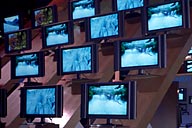 |
 |
 |
| |
 |
 |
 |
 |

The Consumer Electronics Show featured the harbingers of the future. Every manufacturer vies for the prize of market domination. The companies are also looking for orders and insight from the public on what's going to be the must have item for the fall and Christmas 2003 season. Matusita (branded Panasanic in the USA), Sony, Philips, Zenith, Sharp, and other all had good products and exhibits.
Some of the trends we saw:
- in 2003 HDTV's will be affordable
- widescreen (16x9 instead of 4x3) will the the only sets offered
- encrypted programming is coming in music and video
- LCD and plasma thin displays are hot
- blueray DVD is one year away (50 GB storage compared to 5 GB current DVD storage on a single layer)
- NTSC is going away, replaced by the ATSC
Analysis:
 For
television screens over 35 inches, a consumer must choose between five competing
technologies: rear screen projection, front projection, traditional electron
gun CRT, LCD, and plasma displays. Whatever set one gets, they'll need to
find one with a DVI connector, to enable future encrypted DVD and HDTV set-top
box integration. All sets have their shortcomings: plasma displays have a
set life, afterwards they become unusable (3 to 7 years) and plasma's don't
work at higher altitudes. Rear projection and plasma can more readily suffer
from screen burn, which can happen when a standard ratio 4x3 program prematurely
ages the screen phosphors, and one get a dull permanent visible bars on the
side or top of the TV. LCD and CRT are less likely to exhibit screen burn,
but typically cost more than other technologies. Texas Instruments pushed
hard with their home theater DLP projectors, but their resolution is limited
to 720 dpi, compared to similarly priced sets at 1080 dpi. Green Building
Concepts would choose today a good 25-35 inch widescreen Trinitron type flat
screen CRT unit because:
For
television screens over 35 inches, a consumer must choose between five competing
technologies: rear screen projection, front projection, traditional electron
gun CRT, LCD, and plasma displays. Whatever set one gets, they'll need to
find one with a DVI connector, to enable future encrypted DVD and HDTV set-top
box integration. All sets have their shortcomings: plasma displays have a
set life, afterwards they become unusable (3 to 7 years) and plasma's don't
work at higher altitudes. Rear projection and plasma can more readily suffer
from screen burn, which can happen when a standard ratio 4x3 program prematurely
ages the screen phosphors, and one get a dull permanent visible bars on the
side or top of the TV. LCD and CRT are less likely to exhibit screen burn,
but typically cost more than other technologies. Texas Instruments pushed
hard with their home theater DLP projectors, but their resolution is limited
to 720 dpi, compared to similarly priced sets at 1080 dpi. Green Building
Concepts would choose today a good 25-35 inch widescreen Trinitron type flat
screen CRT unit because:
- well known design and hazard
- reduced embodied energy (less energy to manufacture than other technologies)
- 50 years of development
- fault: will consume more electricity than same sized LCD or other flat panel
 Another
aspect of the show, the Environmental Awareness Day, addressed manufactures
design for recyclability and sustainability. The USA maintains complete ignorance
of the subject. In Eurasia, most governments demand from companies a sequence
to retire legacy electronics once they've completed their lifespans. Circuit
boards and transistors are chalk full of poisons like mercury, cadmium, and
lead that if reintroduced in landfills and our water supply, can reek havoc.
Only a few responsible corporate citizens like Ricoh or Canon has measures
to take care of electronics after they have been discarded and assembled.
Most folks do not even know that TV's and compact disc players have toxic
metals and need proper disposal. Most local authorities have regular electronic
waste roundups. Under no circumstance should anyone toss complex electronics
into the household waste stream.
Another
aspect of the show, the Environmental Awareness Day, addressed manufactures
design for recyclability and sustainability. The USA maintains complete ignorance
of the subject. In Eurasia, most governments demand from companies a sequence
to retire legacy electronics once they've completed their lifespans. Circuit
boards and transistors are chalk full of poisons like mercury, cadmium, and
lead that if reintroduced in landfills and our water supply, can reek havoc.
Only a few responsible corporate citizens like Ricoh or Canon has measures
to take care of electronics after they have been discarded and assembled.
Most folks do not even know that TV's and compact disc players have toxic
metals and need proper disposal. Most local authorities have regular electronic
waste roundups. Under no circumstance should anyone toss complex electronics
into the household waste stream.
Two manufacturers received the the brunt of questions at the CES session: Dell Computer and Panasonic, as they are industry leaders. Dell pays a prison labor force to dismantle computers returned to Dell. The best thing Dell does is reuse components and clean motherboards of toxins prior to disposal. They have a long way to go, with little incentive to go any further, unless customers demand it, or if government puts more restrictions on industry. Any action is unlikely in the current political and economic climate.
The second CES session covered energy efficiency in electronics. The USA Department of Energy EnergyStar administrator attended. We were told there are some DVD players and VCR's that draw more power off, than when working! These off power drains are called standby losses, which make up a considerable portion of the electrical load in most nations. Imagine every DVD player, TV, VCR, that need a trickle of electricity to maintain clocks, quick picture tube display, and remote control features. Now consider all the mobile phone charging stations and adapters for computers and the energy loss if plugged in continuously, doing no work. Over 10% of total electrical usage does nothing more than heat a room via these poorly designed voltage adapters and plugs.
 Again,
consumers do not consider the energy efficiency of TV's, telephones, refrigerators,
or other household appliances. Very few devices even list the power requirement
on the outside package or in store display. The representative from Canon
even quipped that his company actions receive no public accolades and may
be a waste of money to pursue further, since it does not save their company
any money. It's only when the consumer refused to buy a product because it
consumes too much power, will corporations begin to design for efficiency
instead of total cost. Often times energy efficiency costs more, but if the
consumer knows that they'll save, we're sure more companies would make the
effort. We need to look for a green label or EnergyStar rating on every electrical
consuming device, and if none exist, demand manufactures to disc
Again,
consumers do not consider the energy efficiency of TV's, telephones, refrigerators,
or other household appliances. Very few devices even list the power requirement
on the outside package or in store display. The representative from Canon
even quipped that his company actions receive no public accolades and may
be a waste of money to pursue further, since it does not save their company
any money. It's only when the consumer refused to buy a product because it
consumes too much power, will corporations begin to design for efficiency
instead of total cost. Often times energy efficiency costs more, but if the
consumer knows that they'll save, we're sure more companies would make the
effort. We need to look for a green label or EnergyStar rating on every electrical
consuming device, and if none exist, demand manufactures to disc
Links:
EPA Plug-In To Recycling
EPA energystar.gov
Nxtcycle
Waste Management
eCycling
Dell Exchange
| Consulting | Digital Lifestyle | DVD Guide | Green Living | Building Hints | Product Tips |
| OS X updates | Free Newsletter | Pricing | Home | Contact | Site Map |
| Search | |||||
|
Copyright © 1997-2006 Green Building Concepts. All rights
reserved. Please click here for the Terms and Conditions of Use applicable to this site. Use of this site signifies your acceptance of the Terms and Conditions of Use. Direct all questions and comments about the web site to | |||||